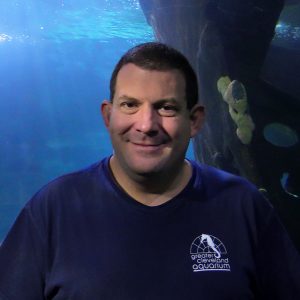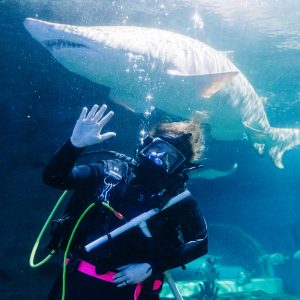5 Things I Learned About Ripsaw Catfish
Primarily found in waterways throughout the Amazon, you’re looking at the ripsaw catfish. Here are 5 things a non-aquarist learned about this fascinating animal at Greater Cleveland Aquarium.
- This species’ genus name—Oxydoras—means sharp skin. With serrated scales and thorn-like hooks for defense along its sides, it’s easy to see how this armored catfish earned the name “ripsaw.”
- Interestingly, these catfish reside in both whitewater and blackwater rivers. Whitewater rivers have higher amounts of suspended sediment and low acidity, while blackwater rivers are slow moving, transparent and more acidic.
- Also called the “talking catfish,” ripsaws make audible grunts and clicks to communicate.
- Like other catfish, a ripsaw’s whiskers are actually sensory organs known as barbels! These organs allow the fish to locate food including larvae, crustaceans and insects.
- You may also notice the ripsaw catfish’s downward-facing mouth. This allows it to scoop food from the riverbottom where it combs for its meals.
With a distinct appearance and relatively large size, it’s hard not to notice the ripsaw catfish. Look for one during your next Greater Cleveland Aquarium visit.

 In 1999, a daring spearfisherman in Greece named Manolis Efthymakis made a stunning discovery. While free-diving 30 feet down, he saw an opening in the cliff wall and did what most of us would not: he swam into it. What he found drew the interest of both the diving and the archaeological community.
In 1999, a daring spearfisherman in Greece named Manolis Efthymakis made a stunning discovery. While free-diving 30 feet down, he saw an opening in the cliff wall and did what most of us would not: he swam into it. What he found drew the interest of both the diving and the archaeological community. A shade over 66 million years ago, a six-mile-wide meteor came screaming out of the heavens at 12 miles per second and a 60-degree angle to the surface of the Earth, which is kind of a worst-case scenario angle in terms of plunging chunks of space rock. It absolutely pulverized the impact zone with the force of a 100 million megaton bomb, creating tsunamis hundreds of feet high and flinging rocks half a continent away. For non-avian dinosaurs, the impact marked the end of an era. Literally. This is where the Mesozoic Era ended, and the Cenozoic began—the infamous K-T Extinction that eliminated roughly 80 percent of all species on the planet.
A shade over 66 million years ago, a six-mile-wide meteor came screaming out of the heavens at 12 miles per second and a 60-degree angle to the surface of the Earth, which is kind of a worst-case scenario angle in terms of plunging chunks of space rock. It absolutely pulverized the impact zone with the force of a 100 million megaton bomb, creating tsunamis hundreds of feet high and flinging rocks half a continent away. For non-avian dinosaurs, the impact marked the end of an era. Literally. This is where the Mesozoic Era ended, and the Cenozoic began—the infamous K-T Extinction that eliminated roughly 80 percent of all species on the planet. When
When  We dive for a variety of reasons. To commune with nature, to unwind, to explore. Our “pale blue dot,” as astrophysicist and author Carl Sagan pointed out, is just a “very small stage in a vast cosmic arena,” but perhaps by diving in we can learn to better appreciate that fragile ecosystem largely invisible to us as we commute between school, work and the grocery store in our busy daily lives.
We dive for a variety of reasons. To commune with nature, to unwind, to explore. Our “pale blue dot,” as astrophysicist and author Carl Sagan pointed out, is just a “very small stage in a vast cosmic arena,” but perhaps by diving in we can learn to better appreciate that fragile ecosystem largely invisible to us as we commute between school, work and the grocery store in our busy daily lives.